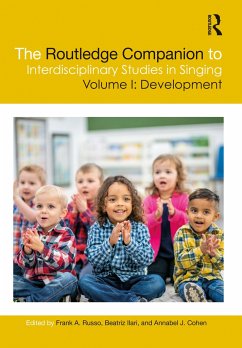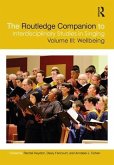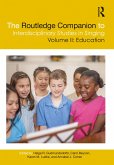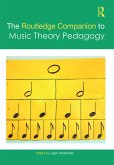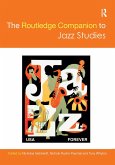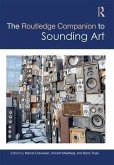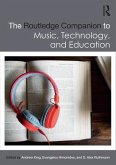The Routledge Companion to Interdisciplinary Studies in Singing, Volume I
Development
Herausgeber: Russo, Frank A.; Cohen, Annabel J.; Ilari, Beatriz
The Routledge Companion to Interdisciplinary Studies in Singing, Volume I
Development
Herausgeber: Russo, Frank A.; Cohen, Annabel J.; Ilari, Beatriz
- Gebundenes Buch
- Merkliste
- Auf die Merkliste
- Bewerten Bewerten
- Teilen
- Produkt teilen
- Produkterinnerung
- Produkterinnerung
The Routledge Companion to Interdisciplinary Studies in Singing, Volume I: Development introduces the many voices necessary to better understand the act of singing-a complex human behaviour that emerges without deliberate training.
Andere Kunden interessierten sich auch für
![The Routledge Companion to Interdisciplinary Studies in Singing, Volume III The Routledge Companion to Interdisciplinary Studies in Singing, Volume III]() The Routledge Companion to Interdisciplinary Studies in Singing, Volume III300,99 €
The Routledge Companion to Interdisciplinary Studies in Singing, Volume III300,99 €![The Routledge Companion to Interdisciplinary Studies in Singing, Volume II The Routledge Companion to Interdisciplinary Studies in Singing, Volume II]() The Routledge Companion to Interdisciplinary Studies in Singing, Volume II300,99 €
The Routledge Companion to Interdisciplinary Studies in Singing, Volume II300,99 €![The Routledge Companion to Music Theory Pedagogy The Routledge Companion to Music Theory Pedagogy]() The Routledge Companion to Music Theory Pedagogy300,99 €
The Routledge Companion to Music Theory Pedagogy300,99 €![The Routledge Companion to Jazz Studies The Routledge Companion to Jazz Studies]() The Routledge Companion to Jazz Studies300,99 €
The Routledge Companion to Jazz Studies300,99 €![The Routledge Companion to Sounding Art The Routledge Companion to Sounding Art]() The Routledge Companion to Sounding Art349,99 €
The Routledge Companion to Sounding Art349,99 €![The Routledge Research Companion to Johann Sebastian Bach The Routledge Research Companion to Johann Sebastian Bach]() The Routledge Research Companion to Johann Sebastian Bach315,99 €
The Routledge Research Companion to Johann Sebastian Bach315,99 €![The Routledge Companion to Music, Technology, and Education The Routledge Companion to Music, Technology, and Education]() The Routledge Companion to Music, Technology, and Education311,99 €
The Routledge Companion to Music, Technology, and Education311,99 €-
-
-
The Routledge Companion to Interdisciplinary Studies in Singing, Volume I: Development introduces the many voices necessary to better understand the act of singing-a complex human behaviour that emerges without deliberate training.
Hinweis: Dieser Artikel kann nur an eine deutsche Lieferadresse ausgeliefert werden.
Hinweis: Dieser Artikel kann nur an eine deutsche Lieferadresse ausgeliefert werden.
Produktdetails
- Produktdetails
- Verlag: Routledge
- Seitenzahl: 522
- Erscheinungstermin: 9. Juni 2020
- Englisch
- Abmessung: 260mm x 183mm x 32mm
- Gewicht: 1166g
- ISBN-13: 9781138059306
- ISBN-10: 1138059307
- Artikelnr.: 69944471
- Herstellerkennzeichnung
- Libri GmbH
- Europaallee 1
- 36244 Bad Hersfeld
- gpsr@libri.de
- Verlag: Routledge
- Seitenzahl: 522
- Erscheinungstermin: 9. Juni 2020
- Englisch
- Abmessung: 260mm x 183mm x 32mm
- Gewicht: 1166g
- ISBN-13: 9781138059306
- ISBN-10: 1138059307
- Artikelnr.: 69944471
- Herstellerkennzeichnung
- Libri GmbH
- Europaallee 1
- 36244 Bad Hersfeld
- gpsr@libri.de
Frank A. Russo is Professor of Psychology at Ryerson University and an affiliate scientist at the Toronto Rehabilitation Institute. Beatriz Ilari is Associate Professor of Music Education and Chair of Music Teaching and Learning at the University of Southern California. Annabel J. Cohen is Professor of Psychology at the University of Prince Edward Island specializing in music cognition and is the initiator/director of the AIRS project.
Introduction: Singing, development, interdisciplinarity, and the
biopsychosocial framework (Frank A. Russo, Beatriz Ilari and Annabel J.
Cohen) / Part I: Musical, historical and scientific foundations of singing
development / 1. Historical, musical, and scientific foundations for
studies of singing: Introduction to Part I (Beatriz Ilari and Frank A.
Russo) / 2. From canonical babbling to early singing and its relation to
the beginnings of speech (Stefanie Stadler Elmer) / 3. An evolutionary
perspective on the human capacity for singing (Nicholas Bannan) / 4.
Salomon Henschen and the Search for a Brain Center for Singing (Amy B.
Graziano, Eric C. Born, and Julene K. Johnson) / 5. The mechanics and
acoustics of the singing voice: registers, resonances and the source-filter
interaction (Joe Wolfe, Maëva Garnier, Nathalie Henrich Bernardoni and John
Smith) / 6. Brain mechanisms underlying singing (Annabel J. Cohen, Daniel
Levitin, and Boris Kleber) / 7. Singing and speech as comparable phenomena:
a dynamical approach (Beatriz Raposo de Medeiros) / 8. Linguistic tone and
melody in the singing of sub-Saharan Africa (Thomas M. Pooley) / 9. The
effects on hormones and age on the voice (Jennifer P. Rodney and Robert T.
Sataloff) / 10. An empirical evaluation of note segmentation of automatic
pitch-extraction methods for the singing voice (Johanna Devaney) / 11.
Annotating multimodal data of singing and speaking (Coralie Vincent) /
Part II: The relation between the perception and production of singing /
12. Perception, vocal production and the development of singing:
Introduction to Part II (Beatriz Ilari) / 13. The role and functions of
infant-directed singing in early development (Simone Falk and Christine D.
Tsang) / 14. Home musical environment and singing development in infancy (
Eugenia Costa-Giomi and Lucia Bennett) / 15. An Exploration of the
Relationships Between Perception, Production, Cognition and Environment in
the Development of Singing in Children (Christine D. Tsang and Laurel J.
Trainor) / 16. Vocal Communication in Birds and Humans - Beyond Song and
Speech (Leslie S. Phillmore and Christine D. Tsang) / 17. Singing and the
child who is deaf: Focusing on the individual (Maria Yennari, Lyn
Schraer-Joiner, and Georgiann Toole) / Part III: Multimodal (audio, visual,
and motor) aspects of singing development / 18. Multimodal Aspects of
Singing Development: Introduction to Part III (Frank A. Russo) / 19.
Infant-directed singing from a dynamic multimodal perspective: Evolutionary
origins, cross-cultural variation, and relation to infant-directed speech (
Sandra E. Trehub and Frank A. Russo) / 20. Before singing: The role of
reflexivity during vocal interactions with caregivers in diaper change
daily routine (Anna Rita Addessi) / 21. Motor system involvement in the
perception of singing (Frank A. Russo) / Part IV: Assessing multiple
singing skills / 22. Measuring the development of singing ability and the
mental testing tradition: Introduction to Part IV (Annabel J. Cohen) / 23.
A meta-analytic perspective on the development of singing in children (
Christina L. Svec) / 24. Construction and validation of the Seattle Singing
Accuracy Protocol (SSAP): An automated online measure of singing accuracy (
Peter Q. Pfordresher and Steven M. Demorest) / 25. Solo or Doubled Singing:
Ecological Validity and Effects in Two Response Modes (Bryan E. Nichols) /
26. Correlations among music aptitude, singing voice development, and
singing accuracy achievement in young children (Catherine M. Tu, Texas A &
M University-Kingsville) / 27. Performance of Canadians on the automated
AIRS Test Battery of Singing Skills: music training and age (Annabel J.
Cohen, Bing Yi Pan, Eric da Silva, and Kyle Dutton) / 28. Analyzing singing
abilities and language skills during the elementary school years (Michael
Forrester) / 29. "What is Your Favorite Song?": Musical Preferences and
Taste in School-Aged Children Over Five Years (Eun Cho, Assal Habibi and
Beatriz Ilari) / 30. How musical culture is reflected in the choice of
favorite songs of Estonian children (Marju Raju, Laura Välja and Jaan Ross
) / 31. Tone-language and musical experience: Pitch accuracy and key choice
in the AIRS Test Battery of Singing Skills (ATBSS) (Annabel J. Cohen,
Jingyuan Sun, Esther Mang, Bing-Yi Pan and Lee Fui Lim) / 32. Effects of
group vocal training in older adults: Pitch accuracy and vocal
improvisation (Jennifer Bugos, Chloe Kantoris, and Joel Pagán) /
Conclusion: Interdisciplinary research in singing development: The way
forward (Annabel J. Cohen, Beatriz Ilari, and Frank A. Russo)
biopsychosocial framework (Frank A. Russo, Beatriz Ilari and Annabel J.
Cohen) / Part I: Musical, historical and scientific foundations of singing
development / 1. Historical, musical, and scientific foundations for
studies of singing: Introduction to Part I (Beatriz Ilari and Frank A.
Russo) / 2. From canonical babbling to early singing and its relation to
the beginnings of speech (Stefanie Stadler Elmer) / 3. An evolutionary
perspective on the human capacity for singing (Nicholas Bannan) / 4.
Salomon Henschen and the Search for a Brain Center for Singing (Amy B.
Graziano, Eric C. Born, and Julene K. Johnson) / 5. The mechanics and
acoustics of the singing voice: registers, resonances and the source-filter
interaction (Joe Wolfe, Maëva Garnier, Nathalie Henrich Bernardoni and John
Smith) / 6. Brain mechanisms underlying singing (Annabel J. Cohen, Daniel
Levitin, and Boris Kleber) / 7. Singing and speech as comparable phenomena:
a dynamical approach (Beatriz Raposo de Medeiros) / 8. Linguistic tone and
melody in the singing of sub-Saharan Africa (Thomas M. Pooley) / 9. The
effects on hormones and age on the voice (Jennifer P. Rodney and Robert T.
Sataloff) / 10. An empirical evaluation of note segmentation of automatic
pitch-extraction methods for the singing voice (Johanna Devaney) / 11.
Annotating multimodal data of singing and speaking (Coralie Vincent) /
Part II: The relation between the perception and production of singing /
12. Perception, vocal production and the development of singing:
Introduction to Part II (Beatriz Ilari) / 13. The role and functions of
infant-directed singing in early development (Simone Falk and Christine D.
Tsang) / 14. Home musical environment and singing development in infancy (
Eugenia Costa-Giomi and Lucia Bennett) / 15. An Exploration of the
Relationships Between Perception, Production, Cognition and Environment in
the Development of Singing in Children (Christine D. Tsang and Laurel J.
Trainor) / 16. Vocal Communication in Birds and Humans - Beyond Song and
Speech (Leslie S. Phillmore and Christine D. Tsang) / 17. Singing and the
child who is deaf: Focusing on the individual (Maria Yennari, Lyn
Schraer-Joiner, and Georgiann Toole) / Part III: Multimodal (audio, visual,
and motor) aspects of singing development / 18. Multimodal Aspects of
Singing Development: Introduction to Part III (Frank A. Russo) / 19.
Infant-directed singing from a dynamic multimodal perspective: Evolutionary
origins, cross-cultural variation, and relation to infant-directed speech (
Sandra E. Trehub and Frank A. Russo) / 20. Before singing: The role of
reflexivity during vocal interactions with caregivers in diaper change
daily routine (Anna Rita Addessi) / 21. Motor system involvement in the
perception of singing (Frank A. Russo) / Part IV: Assessing multiple
singing skills / 22. Measuring the development of singing ability and the
mental testing tradition: Introduction to Part IV (Annabel J. Cohen) / 23.
A meta-analytic perspective on the development of singing in children (
Christina L. Svec) / 24. Construction and validation of the Seattle Singing
Accuracy Protocol (SSAP): An automated online measure of singing accuracy (
Peter Q. Pfordresher and Steven M. Demorest) / 25. Solo or Doubled Singing:
Ecological Validity and Effects in Two Response Modes (Bryan E. Nichols) /
26. Correlations among music aptitude, singing voice development, and
singing accuracy achievement in young children (Catherine M. Tu, Texas A &
M University-Kingsville) / 27. Performance of Canadians on the automated
AIRS Test Battery of Singing Skills: music training and age (Annabel J.
Cohen, Bing Yi Pan, Eric da Silva, and Kyle Dutton) / 28. Analyzing singing
abilities and language skills during the elementary school years (Michael
Forrester) / 29. "What is Your Favorite Song?": Musical Preferences and
Taste in School-Aged Children Over Five Years (Eun Cho, Assal Habibi and
Beatriz Ilari) / 30. How musical culture is reflected in the choice of
favorite songs of Estonian children (Marju Raju, Laura Välja and Jaan Ross
) / 31. Tone-language and musical experience: Pitch accuracy and key choice
in the AIRS Test Battery of Singing Skills (ATBSS) (Annabel J. Cohen,
Jingyuan Sun, Esther Mang, Bing-Yi Pan and Lee Fui Lim) / 32. Effects of
group vocal training in older adults: Pitch accuracy and vocal
improvisation (Jennifer Bugos, Chloe Kantoris, and Joel Pagán) /
Conclusion: Interdisciplinary research in singing development: The way
forward (Annabel J. Cohen, Beatriz Ilari, and Frank A. Russo)
Introduction: Singing, development, interdisciplinarity, and the
biopsychosocial framework (Frank A. Russo, Beatriz Ilari and Annabel J.
Cohen) / Part I: Musical, historical and scientific foundations of singing
development / 1. Historical, musical, and scientific foundations for
studies of singing: Introduction to Part I (Beatriz Ilari and Frank A.
Russo) / 2. From canonical babbling to early singing and its relation to
the beginnings of speech (Stefanie Stadler Elmer) / 3. An evolutionary
perspective on the human capacity for singing (Nicholas Bannan) / 4.
Salomon Henschen and the Search for a Brain Center for Singing (Amy B.
Graziano, Eric C. Born, and Julene K. Johnson) / 5. The mechanics and
acoustics of the singing voice: registers, resonances and the source-filter
interaction (Joe Wolfe, Maëva Garnier, Nathalie Henrich Bernardoni and John
Smith) / 6. Brain mechanisms underlying singing (Annabel J. Cohen, Daniel
Levitin, and Boris Kleber) / 7. Singing and speech as comparable phenomena:
a dynamical approach (Beatriz Raposo de Medeiros) / 8. Linguistic tone and
melody in the singing of sub-Saharan Africa (Thomas M. Pooley) / 9. The
effects on hormones and age on the voice (Jennifer P. Rodney and Robert T.
Sataloff) / 10. An empirical evaluation of note segmentation of automatic
pitch-extraction methods for the singing voice (Johanna Devaney) / 11.
Annotating multimodal data of singing and speaking (Coralie Vincent) /
Part II: The relation between the perception and production of singing /
12. Perception, vocal production and the development of singing:
Introduction to Part II (Beatriz Ilari) / 13. The role and functions of
infant-directed singing in early development (Simone Falk and Christine D.
Tsang) / 14. Home musical environment and singing development in infancy (
Eugenia Costa-Giomi and Lucia Bennett) / 15. An Exploration of the
Relationships Between Perception, Production, Cognition and Environment in
the Development of Singing in Children (Christine D. Tsang and Laurel J.
Trainor) / 16. Vocal Communication in Birds and Humans - Beyond Song and
Speech (Leslie S. Phillmore and Christine D. Tsang) / 17. Singing and the
child who is deaf: Focusing on the individual (Maria Yennari, Lyn
Schraer-Joiner, and Georgiann Toole) / Part III: Multimodal (audio, visual,
and motor) aspects of singing development / 18. Multimodal Aspects of
Singing Development: Introduction to Part III (Frank A. Russo) / 19.
Infant-directed singing from a dynamic multimodal perspective: Evolutionary
origins, cross-cultural variation, and relation to infant-directed speech (
Sandra E. Trehub and Frank A. Russo) / 20. Before singing: The role of
reflexivity during vocal interactions with caregivers in diaper change
daily routine (Anna Rita Addessi) / 21. Motor system involvement in the
perception of singing (Frank A. Russo) / Part IV: Assessing multiple
singing skills / 22. Measuring the development of singing ability and the
mental testing tradition: Introduction to Part IV (Annabel J. Cohen) / 23.
A meta-analytic perspective on the development of singing in children (
Christina L. Svec) / 24. Construction and validation of the Seattle Singing
Accuracy Protocol (SSAP): An automated online measure of singing accuracy (
Peter Q. Pfordresher and Steven M. Demorest) / 25. Solo or Doubled Singing:
Ecological Validity and Effects in Two Response Modes (Bryan E. Nichols) /
26. Correlations among music aptitude, singing voice development, and
singing accuracy achievement in young children (Catherine M. Tu, Texas A &
M University-Kingsville) / 27. Performance of Canadians on the automated
AIRS Test Battery of Singing Skills: music training and age (Annabel J.
Cohen, Bing Yi Pan, Eric da Silva, and Kyle Dutton) / 28. Analyzing singing
abilities and language skills during the elementary school years (Michael
Forrester) / 29. "What is Your Favorite Song?": Musical Preferences and
Taste in School-Aged Children Over Five Years (Eun Cho, Assal Habibi and
Beatriz Ilari) / 30. How musical culture is reflected in the choice of
favorite songs of Estonian children (Marju Raju, Laura Välja and Jaan Ross
) / 31. Tone-language and musical experience: Pitch accuracy and key choice
in the AIRS Test Battery of Singing Skills (ATBSS) (Annabel J. Cohen,
Jingyuan Sun, Esther Mang, Bing-Yi Pan and Lee Fui Lim) / 32. Effects of
group vocal training in older adults: Pitch accuracy and vocal
improvisation (Jennifer Bugos, Chloe Kantoris, and Joel Pagán) /
Conclusion: Interdisciplinary research in singing development: The way
forward (Annabel J. Cohen, Beatriz Ilari, and Frank A. Russo)
biopsychosocial framework (Frank A. Russo, Beatriz Ilari and Annabel J.
Cohen) / Part I: Musical, historical and scientific foundations of singing
development / 1. Historical, musical, and scientific foundations for
studies of singing: Introduction to Part I (Beatriz Ilari and Frank A.
Russo) / 2. From canonical babbling to early singing and its relation to
the beginnings of speech (Stefanie Stadler Elmer) / 3. An evolutionary
perspective on the human capacity for singing (Nicholas Bannan) / 4.
Salomon Henschen and the Search for a Brain Center for Singing (Amy B.
Graziano, Eric C. Born, and Julene K. Johnson) / 5. The mechanics and
acoustics of the singing voice: registers, resonances and the source-filter
interaction (Joe Wolfe, Maëva Garnier, Nathalie Henrich Bernardoni and John
Smith) / 6. Brain mechanisms underlying singing (Annabel J. Cohen, Daniel
Levitin, and Boris Kleber) / 7. Singing and speech as comparable phenomena:
a dynamical approach (Beatriz Raposo de Medeiros) / 8. Linguistic tone and
melody in the singing of sub-Saharan Africa (Thomas M. Pooley) / 9. The
effects on hormones and age on the voice (Jennifer P. Rodney and Robert T.
Sataloff) / 10. An empirical evaluation of note segmentation of automatic
pitch-extraction methods for the singing voice (Johanna Devaney) / 11.
Annotating multimodal data of singing and speaking (Coralie Vincent) /
Part II: The relation between the perception and production of singing /
12. Perception, vocal production and the development of singing:
Introduction to Part II (Beatriz Ilari) / 13. The role and functions of
infant-directed singing in early development (Simone Falk and Christine D.
Tsang) / 14. Home musical environment and singing development in infancy (
Eugenia Costa-Giomi and Lucia Bennett) / 15. An Exploration of the
Relationships Between Perception, Production, Cognition and Environment in
the Development of Singing in Children (Christine D. Tsang and Laurel J.
Trainor) / 16. Vocal Communication in Birds and Humans - Beyond Song and
Speech (Leslie S. Phillmore and Christine D. Tsang) / 17. Singing and the
child who is deaf: Focusing on the individual (Maria Yennari, Lyn
Schraer-Joiner, and Georgiann Toole) / Part III: Multimodal (audio, visual,
and motor) aspects of singing development / 18. Multimodal Aspects of
Singing Development: Introduction to Part III (Frank A. Russo) / 19.
Infant-directed singing from a dynamic multimodal perspective: Evolutionary
origins, cross-cultural variation, and relation to infant-directed speech (
Sandra E. Trehub and Frank A. Russo) / 20. Before singing: The role of
reflexivity during vocal interactions with caregivers in diaper change
daily routine (Anna Rita Addessi) / 21. Motor system involvement in the
perception of singing (Frank A. Russo) / Part IV: Assessing multiple
singing skills / 22. Measuring the development of singing ability and the
mental testing tradition: Introduction to Part IV (Annabel J. Cohen) / 23.
A meta-analytic perspective on the development of singing in children (
Christina L. Svec) / 24. Construction and validation of the Seattle Singing
Accuracy Protocol (SSAP): An automated online measure of singing accuracy (
Peter Q. Pfordresher and Steven M. Demorest) / 25. Solo or Doubled Singing:
Ecological Validity and Effects in Two Response Modes (Bryan E. Nichols) /
26. Correlations among music aptitude, singing voice development, and
singing accuracy achievement in young children (Catherine M. Tu, Texas A &
M University-Kingsville) / 27. Performance of Canadians on the automated
AIRS Test Battery of Singing Skills: music training and age (Annabel J.
Cohen, Bing Yi Pan, Eric da Silva, and Kyle Dutton) / 28. Analyzing singing
abilities and language skills during the elementary school years (Michael
Forrester) / 29. "What is Your Favorite Song?": Musical Preferences and
Taste in School-Aged Children Over Five Years (Eun Cho, Assal Habibi and
Beatriz Ilari) / 30. How musical culture is reflected in the choice of
favorite songs of Estonian children (Marju Raju, Laura Välja and Jaan Ross
) / 31. Tone-language and musical experience: Pitch accuracy and key choice
in the AIRS Test Battery of Singing Skills (ATBSS) (Annabel J. Cohen,
Jingyuan Sun, Esther Mang, Bing-Yi Pan and Lee Fui Lim) / 32. Effects of
group vocal training in older adults: Pitch accuracy and vocal
improvisation (Jennifer Bugos, Chloe Kantoris, and Joel Pagán) /
Conclusion: Interdisciplinary research in singing development: The way
forward (Annabel J. Cohen, Beatriz Ilari, and Frank A. Russo)

